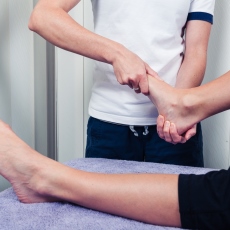
Dystonia

MEDICAL ENCYCLOPEDIA
National Institutes of Health
Dystonia is a movement disorder that causes involuntary contractions of your muscles. These contractions result in twisting and repetitive movements. Sometimes they are painful.
Dystonia can affect just one muscle, a group of muscles or all of your muscles. Symptoms can include tremors, voice problems or a dragging foot. Symptoms often start in childhood. They can also start in the late teens or early adulthood. Some cases worsen over time. Others are mild.
Some people inherit dystonia. Others have it because of another disease. Researchers think that dystonia may be due to a problem in the part of the brain that handles messages about muscle contractions. There is no cure. Doctors use medicines, Botox injections, surgery, physical therapy, and other treatments to reduce or eliminate muscle spasms and pain.
NIH: National Institute of Neurological Disorders and Stroke
- Symptoms and Classifications (Dystonia Medical Research Foundation)
- Botulinum Toxin Injections: A Treatment for Muscle Spasms (American Academy of Family Physicians)Also in Spanish
- Dystonia: Emotional and Mental Health (Dystonia Medical Research Foundation)
- Dystonia: Physical Therapy (Dystonia Medical Research Foundation)
- Employees with Dystonia (Office of Disability Employment Policy)
- Traumatic Injury (Dystonia Medical Research Foundation) - PDF
- Cervical Dystonia (Spasmodic Torticollis) (Mayo Foundation for Medical Education and Research)Also in Spanish
- Forms of Dystonia (Dystonia Medical Research Foundation)
- Musician's Dystonia (Dystonia Medical Research Foundation) - PDF
- Genetics Home Reference: deafness-dystonia-optic neuronopathy syndrome
 (National Library of Medicine)
(National Library of Medicine) - Genetics Home Reference: dopa-responsive dystonia
 (National Library of Medicine)
(National Library of Medicine) - Genetics Home Reference: dopamine transporter deficiency syndrome
 (National Library of Medicine)
(National Library of Medicine) - Genetics Home Reference: dystonia 16
 (National Library of Medicine)
(National Library of Medicine) - Genetics Home Reference: dystonia 6
 (National Library of Medicine)
(National Library of Medicine) - Genetics Home Reference: early-onset primary dystonia
 (National Library of Medicine)
(National Library of Medicine) - Genetics Home Reference: hypermanganesemia with dystonia
 (National Library of Medicine)
(National Library of Medicine) - Genetics Home Reference: myoclonus-dystonia
 (National Library of Medicine)
(National Library of Medicine) - Genetics Home Reference: rapid-onset dystonia parkinsonism
 (National Library of Medicine)
(National Library of Medicine) - Genetics Home Reference: sepiapterin reductase deficiency
 (National Library of Medicine)
(National Library of Medicine) - Genetics Home Reference: task-specific focal dystonia
 (National Library of Medicine)
(National Library of Medicine) - Genetics Home Reference: tyrosine hydroxylase deficiency
 (National Library of Medicine)
(National Library of Medicine) - Genetics Home Reference: X-linked dystonia-parkinsonism
 (National Library of Medicine)
(National Library of Medicine)
- Dystonia
 (National Institute of Neurological Disorders and Stroke)
(National Institute of Neurological Disorders and Stroke)
- ClinicalTrials.gov: Dystonia
 (National Institutes of Health)
(National Institutes of Health) - ClinicalTrials.gov: Torticollis
 (National Institutes of Health)
(National Institutes of Health)
- Botulinum toxin injection - larynx (Medical Encyclopedia)Also in Spanish
- Spasmodic dysphonia (Medical Encyclopedia)Also in Spanish
- Torticollis (Medical Encyclopedia)Also in Spanish






















.png)











No hay comentarios:
Publicar un comentario